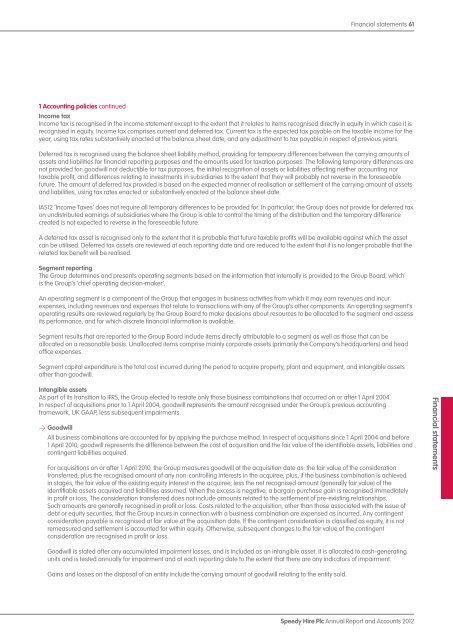Annual Report and Accounts 2012 - Speedy Hire plc
Annual Report and Accounts 2012 - Speedy Hire plc
Annual Report and Accounts 2012 - Speedy Hire plc
Create successful ePaper yourself
Turn your PDF publications into a flip-book with our unique Google optimized e-Paper software.
Financial statements 61<br />
1 Accounting policies continued<br />
Income tax<br />
Income tax is recognised in the income statement except to the extent that it relates to items recognised directly in equity in which case it is<br />
recognised in equity. Income tax comprises current <strong>and</strong> deferred tax. Current tax is the expected tax payable on the taxable income for the<br />
year, using tax rates substantively enacted at the balance sheet date, <strong>and</strong> any adjustment to tax payable in respect of previous years.<br />
Deferred tax is recognised using the balance sheet liability method, providing for temporary differences between the carrying amounts of<br />
assets <strong>and</strong> liabilities for financial reporting purposes <strong>and</strong> the amounts used for taxation purposes. The following temporary differences are<br />
not provided for: goodwill not deductible for tax purposes, the initial recognition of assets or liabilities affecting neither accounting nor<br />
taxable profit, <strong>and</strong> differences relating to investments in subsidiaries to the extent that they will probably not reverse in the foreseeable<br />
future. The amount of deferred tax provided is based on the expected manner of realisation or settlement of the carrying amount of assets<br />
<strong>and</strong> liabilities, using tax rates enacted or substantively enacted at the balance sheet date.<br />
IAS12 ‘Income Taxes’ does not require all temporary differences to be provided for. In particular, the Group does not provide for deferred tax<br />
on undistributed earnings of subsidiaries where the Group is able to control the timing of the distribution <strong>and</strong> the temporary difference<br />
created is not expected to reverse in the foreseeable future.<br />
A deferred tax asset is recognised only to the extent that it is probable that future taxable profits will be available against which the asset<br />
can be utilised. Deferred tax assets are reviewed at each reporting date <strong>and</strong> are reduced to the extent that it is no longer probable that the<br />
related tax benefit will be realised.<br />
Segment reporting<br />
The Group determines <strong>and</strong> presents operating segments based on the information that internally is provided to the Group Board, which<br />
is the Group’s ‘chief operating decision-maker’.<br />
An operating segment is a component of the Group that engages in business activities from which it may earn revenues <strong>and</strong> incur<br />
expenses, including revenues <strong>and</strong> expenses that relate to transactions with any of the Group’s other components. An operating segment’s<br />
operating results are reviewed regularly by the Group Board to make decisions about resources to be allocated to the segment <strong>and</strong> assess<br />
its performance, <strong>and</strong> for which discrete financial information is available.<br />
Segment results that are reported to the Group Board include items directly attributable to a segment as well as those that can be<br />
allocated on a reasonable basis. Unallocated items comprise mainly corporate assets (primarily the Company’s headquarters) <strong>and</strong> head<br />
office expenses.<br />
Segment capital expenditure is the total cost incurred during the period to acquire property, plant <strong>and</strong> equipment, <strong>and</strong> intangible assets<br />
other than goodwill.<br />
Intangible assets<br />
As part of its transition to IFRS, the Group elected to restate only those business combinations that occurred on or after 1 April 2004.<br />
In respect of acquisitions prior to 1 April 2004, goodwill represents the amount recognised under the Group’s previous accounting<br />
framework, UK GAAP, less subsequent impairments.<br />
> > Goodwill<br />
All business combinations are accounted for by applying the purchase method. In respect of acquisitions since 1 April 2004 <strong>and</strong> before<br />
1 April 2010, goodwill represents the difference between the cost of acquisition <strong>and</strong> the fair value of the identifiable assets, liabilities <strong>and</strong><br />
contingent liabilities acquired.<br />
For acquisitions on or after 1 April 2010, the Group measures goodwill at the acquisition date as: the fair value of the consideration<br />
transferred; plus the recognised amount of any non-controlling interests in the acquiree; plus, if the business combination is achieved<br />
in stages, the fair value of the existing equity interest in the acquiree; less the net recognised amount (generally fair value) of the<br />
identifiable assets acquired <strong>and</strong> liabilities assumed. When the excess is negative, a bargain purchase gain is recognised immediately<br />
in profit or loss. The consideration transferred does not include amounts related to the settlement of pre-existing relationships.<br />
Such amounts are generally recognised in profit or loss. Costs related to the acquisition, other than those associated with the issue of<br />
debt or equity securities, that the Group incurs in connection with a business combination are expensed as incurred. Any contingent<br />
consideration payable is recognised at fair value at the acquisition date. If the contingent consideration is classified as equity, it is not<br />
remeasured <strong>and</strong> settlement is accounted for within equity. Otherwise, subsequent changes to the fair value of the contingent<br />
consideration are recognised in profit or loss.<br />
Goodwill is stated after any accumulated impairment losses, <strong>and</strong> is included as an intangible asset. It is allocated to cash-generating<br />
units <strong>and</strong> is tested annually for impairment <strong>and</strong> at each reporting date to the extent that there are any indicators of impairment.<br />
Gains <strong>and</strong> losses on the disposal of an entity include the carrying amount of goodwill relating to the entity sold.<br />
<strong>Speedy</strong> <strong>Hire</strong> Plc <strong>Annual</strong> <strong>Report</strong> <strong>and</strong> <strong>Accounts</strong> <strong>2012</strong><br />
Financial statements


